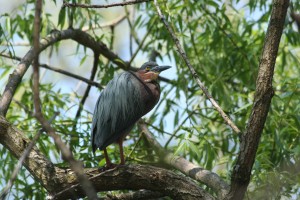Plan Your Weekend: Prime Time for Bird Watching
Posted in Programs and Events, Wildlife on May 29 2009, by Plant Talk
Spring Brings Special Sightings
 |
Debbie Becker leads a free bird walk at the Garden every Saturday from 11 a.m. to 12:30 p.m., beginning at the Reflecting Pool in the Leon Levy Visitor Center. The last one for the season will be June 27. |
Three fuzzy heads can be seen bobbing up and down in the red-tailed hawk nest. Just like Central Park’s Pale Male and Lola, our red-tails have made a neat little “cliffside” home at the top of a structure—in this case the Library building. It is interesting to watch mom and pop fly in with food to feed the babies. The hawks’ diet consists mainly of small mammals (such as squirrels and chipmunks) and birds, keeping the balance of nature in check. The female red-tail seems to find mockingbirds a special treat and has resorted to robbing mockingbird nests. Recently, we saw the red-tail perched atop the Watson Building with a baby mockingbird in her talons and mother mocker desperately trying to get mother hawk to free her prey. The mocker aggressively attacked the hawk, but in the end the hawk had a meal for her babies and the mocker went home to an empty nest. It is the circle of life.
While searching for warblers in the Forest we were treated to a very rare sight at this time of year: Our well-hidden female great horned owl flew from her perch followed by her fledgling. We were able to follow the mature owl to a new perch but lost the young owl in the leaves. As we watched the mom settle in, she kept looking around for her baby. Suddenly she looked forward and began to hoot. Then she turned her head right and hooted and then left and hooted. I guess she heard the young owl reply, because she closed her eyes and seemingly went to sleep.
 As the warbler numbers begin to dwindle, the birds having moved on to northern climes, we are grateful for another wonderful migration. Most of us were treated to the sightings of warblers such as black-throated blue, black-throated green, northern parula, Tennessee, chestnut-sided, bay-breasted, American redstart, common yellowthroat, yellow, prothonotary, and ovenbird. We also had warbling, red-eyed, and blue-headed vireos and a long list of other spectacular birds: Baltimore oriole, scarlet tanager, rose-breasted grosbeak, wood thrush, veery, hermit thrush, gray catbird, brown creeper, house wren, rough-winged swallow, bank swallow, tree swallow, chimney swift, eastern kingbird, great blue heron, great egret, night-heron, green heron (in full breeding plumage, see above photo, courtesy Debbie Becker), cormorant, wood duck (adults with 11 babies), mallard (adults with 12 babies) indigo bunting, cedar waxwing, savannah sparrow, ruby-throated hummingbird, eastern towhee, and northern flicker.In addition, we of course regularly spot our resident birds: blue jays, cardinals, crows, nuthatches, chickadees, downy woodpeckers, hairy woodpeckers, red-bellied woodpeckers, goldfinch, house finch, song sparrows, and more.
As the warbler numbers begin to dwindle, the birds having moved on to northern climes, we are grateful for another wonderful migration. Most of us were treated to the sightings of warblers such as black-throated blue, black-throated green, northern parula, Tennessee, chestnut-sided, bay-breasted, American redstart, common yellowthroat, yellow, prothonotary, and ovenbird. We also had warbling, red-eyed, and blue-headed vireos and a long list of other spectacular birds: Baltimore oriole, scarlet tanager, rose-breasted grosbeak, wood thrush, veery, hermit thrush, gray catbird, brown creeper, house wren, rough-winged swallow, bank swallow, tree swallow, chimney swift, eastern kingbird, great blue heron, great egret, night-heron, green heron (in full breeding plumage, see above photo, courtesy Debbie Becker), cormorant, wood duck (adults with 11 babies), mallard (adults with 12 babies) indigo bunting, cedar waxwing, savannah sparrow, ruby-throated hummingbird, eastern towhee, and northern flicker.In addition, we of course regularly spot our resident birds: blue jays, cardinals, crows, nuthatches, chickadees, downy woodpeckers, hairy woodpeckers, red-bellied woodpeckers, goldfinch, house finch, song sparrows, and more.
With June just around the corner we can look forward to watching the orioles, kingbirds, hawks, herons, robins, catbirds, blue jays, cardinals, and thrush build their nests and raise their broods. The orioles build interesting sock-like hanging nests in many different places at NYBG. Once we locate a nest it is fun to watch the family—which often consists of mom, dad, and an immature male (in training for next year’s chick rearing)—take care of the general housekeeping and feeding of the chicks. The eastern kingbird often has its babies lined up on a branch over the pond or lakes and takes pride in showing the chicks how to hunt for abundant dragonflies. The robins run along the lawns pulling worms from their burrows to deliver to eagerly awaiting gaping mouths back at the nest. But the most entertaining this June will be watching the immature red-tailed hawks begin to flap their wings and go for flying lessons. What better way to pass a Saturday morning in June than sitting on the lawn with your binoculars and watching one of nature’s greatest shows.
The last bird walk will be held June 27, when we break for the summer. We return September 5, in time for the great fall migration when we will see all the above-mentioned birds coming through the Garden on their way south to their winter homes.
Check out all of Saturday’s programming
Check out all of Sunday’s programming

